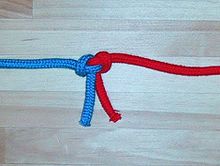knot (noun) /nɑt/


A looping of a piece of string or of any other long, flexible material that cannot be untangled without passing one or both ends of the material through its loops.
(of hair, etc) A tangled clump.
A maze-like pattern.
(mathematics) A non-self-intersecting closed curve in (e.g., three-dimensional) space that is an abstraction of a knot (in sense 1 above).
A difficult situation.
The whorl left in lumber by the base of a branch growing out of the tree's trunk.
Local swelling in a tissue area, especially skin, often due to injury.
A tightened and contracted part of a muscle that feels like a hard lump under the skin.
A protuberant joint in a plant.
Any knob, lump, swelling, or protuberance.
The swelling of the bulbus glandis in members of the dog family, Canidae.
The point on which the action of a story depends; the gist of a matter.
(engineering) A node.
A kind of epaulet; a shoulder knot.
A group of people or things.
A bond of union; a connection; a tie.
(aviation, nautical) A unit of speed, equal to one nautical mile per hour. (From the practice of counting the number of knots in the log-line (as it is paid out) in a standard time. Traditionally spaced at one every 1⁄120 of a mile.)
(aviation) A unit of indicated airspeed, calibrated airspeed, or equivalent airspeed, which varies in its relation to the unit of speed so as to compensate for the effects of different ambient atmospheric conditions on aircraft performance.
(nautical) A nautical mile.
(slang) The bulbus glandis.
(fandom slang) In omegaverse fiction, a bulbus glandis-like structure on the penis of a male alpha, which ties him to an omega during intercourse.
One of a variety of shore birds; red-breasted sandpiper (variously Calidris canutus or Tringa canutus).
knot (verb) /nɑt/
(transitive) To form into a knot; to tie with a knot or knots.
(transitive) To form wrinkles in the forehead, as a sign of concentration, concern, surprise, etc.
To unite closely; to knit together.
(intransitive) To form knots.
(intransitive) To knit knots for a fringe.